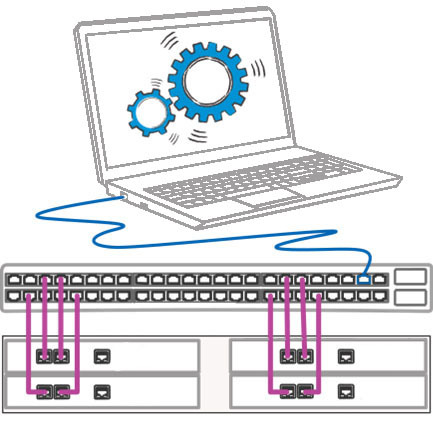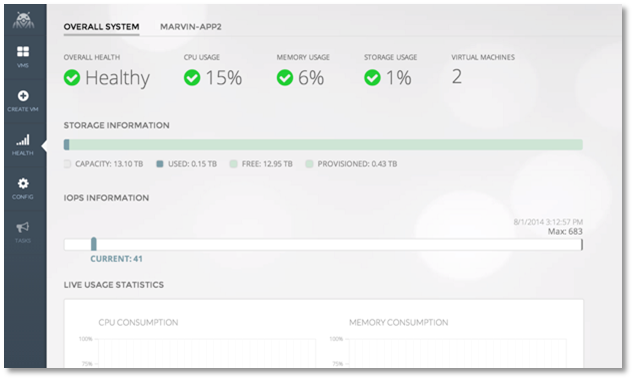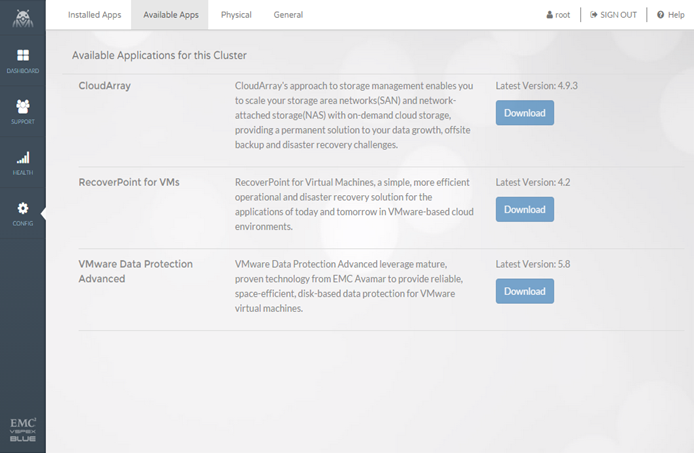The onset of the era of hyperconvergence

One of the main directions in the evolution of IT-systems is the desire for compactness, versatility and ease of use. One example is the development of computers. They went through the stages of evolution from huge piece systems with a volume of tens of cubic meters, designed for a very limited number of tasks, to universal personnel and servers. Personal computers, in turn, also changed, acquiring more and more possibilities, becoming more uniform in element base and more accessible to mastering, having gone from a garage assembly to assembled from typical system components, and, as a result, to relatively inexpensive high-power devices of factory assembly from installed software, completely ready to work out of the box. Similar processes, with certain adjustments, proceeded in many other industries. Equipment for building industrial infrastructure was no exception.
Smartphone ideology
Until recently, the dominant approach to the creation of industrial IT-systems was "do it yourself". In the IT departments, one specialist was involved in the creation of server clusters, others - data storage systems, and third - network infrastructure. Systems were built from heterogeneous components, often without taking into account the features of adjacent systems. As a result, as the company's infrastructure developed and became more complex, the costs of support and modernization increased nonlinearly, not to mention the complexity and complexity of maintaining and restructuring many processes.
The current situation gave rise to the emergence of convergent systems. As part of a complex corporate infrastructure, independent, autonomous subsystems were created based on solutions from a small number of vendors, often with a single entry point for technical support and maintenance. This allowed significant costs and labor intensity in the construction and modernization of infrastructure.
')
However, the isolation of computing power, storage systems and network equipment integrated at vendors' production sites over time also ceased to meet the demands of time. The rapid development of cloud systems, which has become a constant, the constant growth of processed and stored data, the need for rapid adaptation of infrastructure to changing market conditions, as well as the increasing role of workload management are all signs of our time. In conditions when it is necessary to scale the system quickly and often, the cost of recalculating and re-equipping convergent systems squander IT budgets, and the laboriousness of the process depresses all concerned people. All this led to the emergence of hyperconvergent systems.
The ideology of hyperconvergence is based on such concepts as:
- Modularity.
- Hardware integration of computing power, disk subsystem and network switch.
- Minimum need for initial setup to get started.
- Use of typical components.
A hyper-converged system is a server, storage system, and a network switch combined in a single package. However, the cherry on the cake, which makes this trio a full-fledged building brick, is adapted software, including controllers.
In fact, a hyperconvergent system can be compared with a smartphone: both are a kind of mass device with well-known capabilities, not requiring adjustment and debugging, working almost out of the box, with the widest compatibility and versatile in use. Not surprisingly, hyperconvergent systems are becoming increasingly popular. Many small and medium-sized companies, especially those without large staff of IT-specialists, very quickly deploy compact, inexpensive and very flexible scalable data storage and processing systems using such systems.
Let's take a closer look at convergent systems using the example of one of the brightest representatives, EMC VSPEX Blue, designed to create virtualized environments, run business applications, deploy virtual desktops, and organize environments for testing and development.

Hardware component
As already mentioned, the advantages of convergent systems stem from the sum of two components: hardware and software.
VSPEX Blue is a standard 2U device that hosts four hot-swappable nodes. Each node contains:
- Computing module based on two Intel Xeon E5-2620 V2 processors, 128 or 192 GB RAM.
- Storage system based on hard drives and SSD-drives (up to 4 pcs) with built-in SAT / SAS controller.
- One SLC SATADOM 32 GB module (ESXi boot image).
- Dual-port network switch, 10 GbE SFP + or 1 GbE 1000Base-T.
- Two 1200 watt power supplies.


Note that the nodes are based on the standard x86 architecture. All other components are also typical models.
The VSPEX Blue deployment process is very simple: you need to connect all four nodes to the top-level rack switches, connect a laptop to it, configure the switch, turn on the power and go to the VSPEX Blue page in your web browser.

Software component
The key component of VSPEX Blue is not hardware, but software. Package Included:
- vSphere Data Protection Advanced with Data Domain Integration . One of the best in its class products. Designed to create backups and restore them both locally and remotely. It has built-in deduplication. Recovers data from a copy in one step, with the ability to recover. Integration with external EMC Data Domain backup storage is supported.
- EMC RecoverPoint for virtual machines . Provides continuous data protection and operational and disaster recovery at any time for 15 virtual machines. It has a built-in orchestration, integrates with VMware vCenter. Provides local and remote, synchronous and asynchronous replication.
- EMC CloudArray . Allows you to integrate VSPEX Blue into third-party scalable object cloud storage of many service providers (Amazon S3, Google, etc.). For local systems, it represents such storages in the form of NAS or SAN arrays.
- EMC Secure Remote Services (ESRS) . Provides remote two-way communication between customer support and VSPEX Blue. Allows you to automatically download and install updates without stopping the system.
- VSPEX Blue Manager . Designed for comprehensive system management. In particular, VSPEX Blue Manager allows you to integrate web services support, manage software catalogs and automated software updates. The application contains a service for monitoring the status of events and alerts. In general, the capabilities of the VSPEX Blue Manager significantly exceed the functionality of the EVO: RAIL Manager.


Among other things, VSPEX Blue Manager includes ... VSPEX Blue Market app store. This is again a question about the “smartphone ideology”. In this store, you can purchase additional software and hardware from both EMC and partner companies.

VSPEX Blue Features
All operations are automated as much as possible. In particular, setting up a vCenter server, setting up an ESXi host and VSAN virtual network, as well as making all the settings that a vendor cannot perform without knowing the actual IP addresses. In total, over 200 standard EVO: RAIL operations have been automated. Full system configuration to the state of readiness for application deployment takes about 15 minutes.
Installing software updates and patches also occurs after checking and without system downtime. To update entire clusters, just a few clicks is enough.
The system supports horizontal scaling to 4 devices, totally with 16 nodes. In this case, the detection of each device in the network, as well as its nodes, occurs automatically. Also, without human intervention, the workload is distributed between nodes and configurations and a single storage pool is created.
Through the use of vSphere and VSAN, the system provides fine disk memory reservation, instant snapshots, clone creation, encryption, and efficient granularity at the virtual machine level for all data storage operations.
Conclusion
The main advantages of hyperconvergent systems are simplicity of deployment and low cost, including from the point of view of further scaling. High automation and control based on pre-set rules make it possible to flexibly and easily manage the distribution of resources and workload. These factors, as well as the great popularity of hyperconvergent systems, indicate that in a relatively near future, such systems will occupy a major market share. And about the times when employees of IT-departments independently assembled, set up and linked servers and storage systems to each other will be written in books on the history of information technology development.
Source: https://habr.com/ru/post/259447/
All Articles